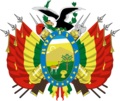| Coat of arms of Bolivia | |
|---|---|
 | |
| Armiger | Plurinational State of Bolivia |
| Adopted | 2004 |
| Crest | Andean condor |
| Supporters | Flags of Bolivia |
The coat of arms of Bolivia has a central cartouche surrounded by Bolivian flags, cannons, laurel branches, and has an Andean condor on top.








